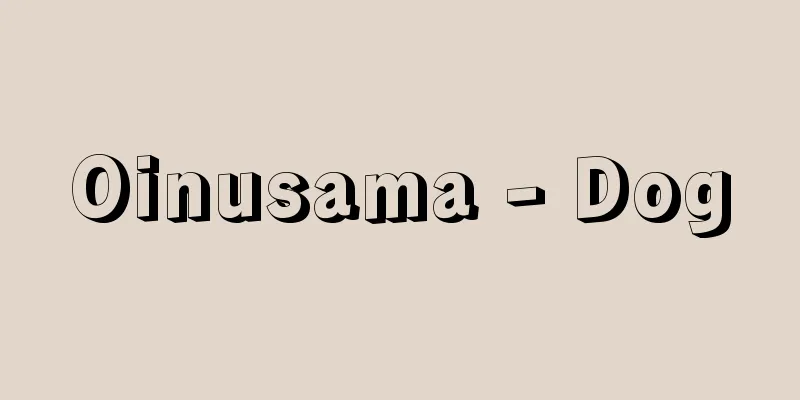Triangular-rimmed divine beast mirror - Sankakubuchishinjukyo

Among the mirrors that depict the gods and beasts that appear in ancient Chinese mythology in relief style, those with triangular protruding edges are called "mirrors". Many of them are large, over 20 cm in diameter, and were made in the 3rd century following the trend of the beast mirrors and image mirrors of the Later Han (→ Han) period. They include mirrors inscribed with dates from the Wei period of the Three Kingdoms period, such as Jingchu 3 (239) and Zhengshi 1 (240). More than 330 imported mirrors have been excavated, the most of any mirror excavated from a Japanese ancient tomb, but no examples have been excavated in China or the Korean peninsula. More than 30 mirrors have been excavated from the Tsubakii Otsukayama Tomb in Kizugawa City, Kyoto Prefecture, and 33 from the Kurozuka Tomb in Tenri City, Nara Prefecture. Mirrors made from the same mold are distributed in various places, and it is believed that they were distributed to chiefs throughout the country through several oyamoto in the Kinki region, including the person buried in the tomb. The Gishi Wajinden records that in the third year of the Jingchu era, 100 bronze mirrors were bestowed upon Himiko, the queen of Wa, who paid tribute to Wei. The prevailing theory is that the triangular-rimmed divine beast mirror was a mirror specially produced by Wei as a gift to Wa. Diplomatic relations continued between Wa and Wei, and in the second year of the Taishi era (266), Iyo paid tribute to the Western Jin (→Jin). Given the changes in style, it is believed that multiple types of triangular-rimmed divine beast mirrors were continuously imported during this series of negotiations. In recent years, theories have been put forward that the triangular-rimmed divine beast mirror was domestically produced, or that it was produced by immigrants from Wu, but the established theory has not been overturned.Triangular-rimmed divine beast mirrorPlease see the "Triangular-rimmed Divine Animal Mirror" page. Source: Encyclopaedia Britannica Concise Encyclopedia About Encyclopaedia Britannica Concise Encyclopedia Information |
古代中国の神話に登場する神仙や霊獣を浮彫風に表現した鏡のうち,周縁部断面が三角形状に突出するものをいう。直径 20cmをこえる大型品が多く,後漢(→漢)代の神獣鏡や画像鏡の流れを受けて 3世紀に製作されたもので,景初3(239)年,正始元(240)年など,三国時代の魏の年号をもつ紀年銘鏡を含む。舶載鏡とされるものだけで 330面以上が出土し,日本の古墳出土鏡中,最も多いが,中国や朝鮮半島では出土例がない。京都府木津川市の椿井大塚山古墳からは 30面以上が出土,奈良県天理市にある黒塚古墳からも 33面が出土,各地に同じ鋳型からつくられた同笵鏡が分布しており,古墳の被葬者を含めた近畿地方の複数の大親元を通じ,全国の首長に配布されたと考えられている。「魏志倭人伝」には,景初3年,魏に朝貢した倭の女王卑弥呼に銅鏡 100面を下賜した記事が見えるが,三角縁神獣鏡は倭への下賜品として魏が特別製作した鏡であるとする説が有力である。倭と魏の間には以後も外交関係が続き,泰始2(266)年には壹与が西晋(→晋)に朝貢している。三角縁神獣鏡は型式変化の点からも,これら一連の交渉に伴い複数の種類が継続的に輸入されたと考えられる。近年,三角縁神獣鏡の国産説や呉の渡来人製作説なども出されているが,定説を覆すにはいたっていない。
三角縁神獣鏡
|
>>: Mountaineers - Montagnards (French)
Recommend
Skärholmen (English spelling)
... The construction of new cities was also thriv...
Itaura Zori - Wooden sole sandals
〘 noun 〙 Sandals with a split board stuck to the s...
Bottlenose dolphin (Hando sea pig) - Bottlenose dolphin (English spelling)
A mammal of the family Delphinidae in the suborder...
Cession (English spelling)
A method of acquiring or losing national territor...
Brick - Brick (English spelling)
A type of building material made primarily from cl...
Scaled weasel - Scaled weasel
…They have almost no relationship with humans. In...
Flat glass - Itagarasu (English spelling) Flat glass
A general term for glass products made into plate...
Biainili
…At its height, it occupied the entire Armenian P...
Manichaeism - Manichaeism
It is a universal religion founded by Mani in the...
Trauma
It refers to an injury caused to a part of the bo...
Carpini, J.
…His English name was John. He was from Piano di ...
Land surveying pole - Kenchizao
A surveying tool used during land surveys. Also ca...
Camphor [town] - Camphor
A former town in Asa County, located in the wester...
Carcar, G.da (English spelling) CarcarGda
… In this historical context, A. Vesalius, the fa...
Robed nobility - French for "houfukukizoku" (English: Noblesse de robe)
The new nobility was made up of holders of high-r...





![Kobe [town] - Godo](/upload/images/67cb8a73ec88f.webp)



